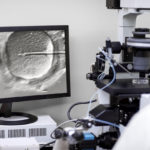News
What Is IVF and How Is It Done?

Patients seeking infertility treatment commonly ask “what is IVF and how is it done?” IVF is an acronym for In Vitro Fertilization which means to fertilize an egg with sperm outside of the body (generally in a petri dish) and placed in an incubator for a sufficient time (generally 5 days) until it is transferred back in to the uterus (womb).
Five Stages of the IVF Process
There are 5 steps in the IVF process. These are:
- Medication: Stimulate the ovaries to make eggs;
- Harvest the Eggs: Collection of the eggs;
- Fertilization: Fertilization of the eggs;
- Embryo Culture: Growing embryos in culture;
- Embryo Transfer: Transfer of an embryo into the uterus.
1) How Are the Ovaries Stimulated to Make Eggs?
Medication are used to stimulate the ovaries to make eggs. These medications often include:
- Pre-treatment with either birth control pills for 2 to 3 weeks the cycle before stimulation starts in an effort to collect more mature eggs as only mature eggs can fertilize. Sometimes in cases where there is evidence of diminished ovarian reserve (not many eggs as indicated by low AMH, low antral follicle count, or high FSH), an estrogen priming cycle is chosen. This involves estrogen pills or skin patches along with 3 nights of an under the skin (sub-cutaneous) injection of Cetrotide:
- Treatment with Follicle Stimulating Hormone (FSH) whose brand names include Gonal F, Follistim or Menopur. Menopur also contains Luteinizing Hormone (LH) in addition to LH. These medications may be given in AM, PM or twice a day depending on the individual protocol chosen. The average time on these medications are usually 8 to 10 days but varies according to how well the ovaries are responding and the dose used. During this time monitoring occurs checking blood levels of estrogen, progesterone and a vaginal ultrasound to check ovarian follicle size and number. When judged ready, a trigger shot most commonly human chorionic gonadotropin (hCG) is given to enable the eggs to initiate their final maturation division;
- A medication to suppress ovulation during FSH stimulation is also necessary. One such medication, Lupron is started in the second half of the cycle before FSH stimulation begins. Another medication, Cetrotide is given several days after FSH stimulation has begun. Sometimes a micro dose of Lupron is selected called a Microflare protocol in which case a small dose of Lupron is used twice a day beginning the night of Cycle Day 2 of the cycle that FSH is started.
2) How Are Eggs Collected?
Egg retrieval (ER) is performed approximately 36 hours after the hCG trigger shot under anesthesia using an ultrasound guided vaginal probe attached to a needle guide. A needle goes through the back wall of the vagina into the ovary so that ovarian follicles hopefully containing eggs can be drained into warmed test tubes. These are then handed to the embryologist who will isolate the eggs from its attached accompanying cells and put them in the incubator until they are fertilized.
3) How Are Eggs Fertilized?
There are two ways to inseminate eggs so they may fertilize. These are:
- Standard Insemination (SI) which is placing 10,000 moving sperm with each harvested egg under a drop of oil in embryo culture media;
- Intracytoplasmic Sperm Insemination (ICSI) which involves placing one sperm into each egg. ICSI is generally performed in cases where there are problems with the sperm such as low count, motility or poor morphology, in cases where there has been failed fertilization, Pre-Implantation Genetic Testing (PGT) will be done, and in cases to maximize fertilization.
Following SI or ICSI the culture plates (petri dishes) containing eggs and sperm are placed in the incubator and checked the next day for fertilization.

4) How Are Embryos Cultured?
Embryos are cultured (kept in the incubator) for 5 days. In the past embryos were kept in culture for only 3 days but that was before more advanced culture systems and better incubators were available. It is now known that he male genome is not fully integrated until three days following fertilization so culturing embryos for 5 days allows better determination of embryo competence. While the embryos are being cultured most centers prescribe some form of estrogen and progesterone to take following the egg retrieval.
5. How is An Embryo Transferred?
Embryo transfer (ET) occurs on the 5th day following fertilization and is performed under ultrasound guidance. The transfer is not painful but is generally uncomfortable because it is performed after drinking a liter of water to fill the bladder. A full bladder makes it easier to see the uterus under ultrasound guidance and pushes the uterus down so it is easier to accomplish the transfer. A two stage process is done by placing an outer catheter into the uterus and then calling for the embryo to be loaded into a transfer catheter which is thread through the outer catheter to approximately 2 cm from the top of the uterus. At that point the plunger on the syringe that is attached to the catheter and the embryo is injected. In the past many centers advised patients to have a ‘mock’ or pretend transfer to determine whether the transfer would be difficult. This is no longer necessary as the two stage technique and ultrasound guidance obviates the need for a ‘mock’ transfer.
How many embryos to transfer depends on many different clinical variables but in general an elective single embryo transfer is performed in all women 37 years of age or younger. Remaining embryos of suitable quality can be vitrified (frozen) for later use, if necessary.
Following transfer it is not necessary to lie down for more than a minute. A study from Spain showed that higher pregnancy success rates were achieved if the woman got up following transfer compared to lying down for 10 minutes or more. A pregnancy test is performed 10 days following transfer. Most centers continue estrogen and progesterone therapy through this time and into early pregnancy.
How Can I Get More Information About IVF?
At Fertility Centers of New England, we have a wealth of experience with IVF. If you have more questions on “what is IVF and how is it done?” or infertility treatment options, please contact us today to schedule a consultation with one of our fertility experts.



